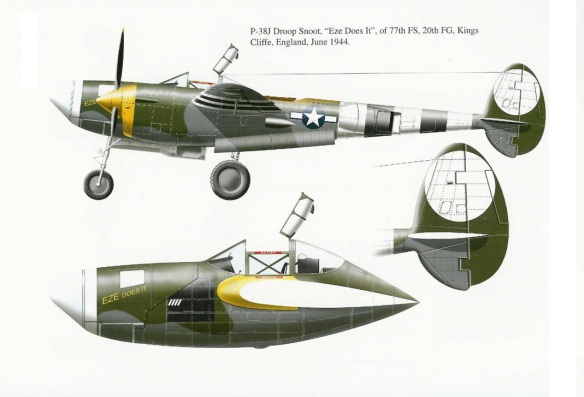On 27 January 1939 at March Field in Riverside, California, the prototype XP-38 (37-457) was taken aloft on its maiden flight by Lieutenant Benjamin S. Kelsey. With Thunderbolt and Mustang, the name Lightning has become synonymous with American fighter aviation. A total of 9,895 Lockheed Lightnings was manufactured for US forces by VJ-Day, and the twin-boom ‘forked-tail devil’ fought in every theatre of war, a potent and adaptable air-combat machine not easily defeated in battle, not even by Axis fighters developed considerably later.
Lockheed’s Burbank, California, design team headed by H. L. Hibbard, including Clarence L. (Kelly) Johnson and prodded by chief executive Robert Gross, shaped the XP-38 to meet a 1938 US Army specification for a high-altitude pursuit ship capable of 360 mph (579.3 kmh) at 20,000 ft (6096 m). Its twin-boom configuration freed the fighter’s nose for unsynchronised guns and produced a broad, sturdy warplane with respectable range able to carry 4,000 lb (1814.4 kg) bf underwing ordnance. The prototype, powered by 960-hp (715.9 kW) Allison V-1710-11/15 engines driving inward-rotating propellers, was brought out of secrecy for an 11 February 1939 transcontinental speed dash, crossing the US in 7 hrs 2 min with two refuelling stops, but was lost when it undershot the runway at Mitchell Field, NY.
Thirteen YP-38 service-test airframes followed and demonstrated promise, powered by two 1,150-hp (857.6-kW) V-1710-27129 engines with outward-rotating propellers. One XP-38A was built for experiments with a pressurised cockpit. Armament on these pre-production Lightnings was one 37-mm Oldsmobile cannon, two 0.5-in (12.7-mm) machine-guns and two 0.3-in (7.62-mm) machine-guns).
P-38B and P-38C proposals failed to produce actual hardware and the first production order was for 35 P-38Ds followed by 210 P-38Es with the smaller 20-mm Hispano nose cannon. The P-38D introduced self-sealing fuel tanks and armour protection, and was in service with the 27th Pursuit Squadron, 1st Pursuit Group, Selfridge Field, Michigan, by October 1941, just before US entry into the war. P-38Es served with 12 squadrons and some fought in the Aleutians. A British order for 143 Lightning Mk Is Oiled to satisfy RAF needs (as they were delivered without turbochargers), and most of these airframes reverted to the newly-renamed US Army Air Forces (USAAF) as trainers, called P-322s. The Lightning Mk I1 also had a short career wearing British roundels and, again, was not fully successful even though American pilots were finding the Lightning fully competitive with the Mitsubishi Zero and Messerschmitt Bf 109.
Some 527 improved P-38F fighters, 20 completed as F-4A photoreconnaissance craft, were followed by 1,082 P-38Gs, including 181 converted to F-5A and 200 to F-5B photo-planes. On 12 April 1943, P-38Gs led by Captain Thomas G. Lanphier intercepted and shot down the Mitsubishi G4M carrying Admiral Isoroku Yamamoto, the master strategist of Pearl Harbor and Midway. A total of 601 heavier P-38Hs, 128 of them converted to F-5C reconnaissance standard, fought mainly in Europe among the 87 USAAF squadrons which operated Lightnings.
The only major change in the Lightning during its long production life took place with the P-38J, when the intakes under the engines were enlarged to house core-type intercoolers, the curved windscreen was replaced by a flat panel, and the boom-mounted radiators were enlarged. The P-38J powered by 1,425-hp (1062.6 kW) V-1710-89/91 engines entered combat in August 1943 carrying drop-tanks which stretched its range to 2,300 miles (3701 km), making possible long-distance penetration flights into Hitler’s ‘Fortress Europe’.
The first bomber-escort missions to Berlin were flown by P-38s which, at the extreme of range, finally seemed to have met their match in the nimble Focke-Wulf Fw 190. In the Pacific, P-38s remained at the front-line of battle as the island-hopping campaign progressed. The P-38L variant, produced in greatest numbers (3,923), including 113 built by Vultee in Nashville, Tennessee, was powered by 1,600-hp (1193.1-kW) V-1710-111/113 engines and proved especially effective in the Pacific, as did its F-5G reconnaissance version. A few became TP-38L aircraft with tandem seating for training purposes configured so awkwardly that the rear-seat instructor had to keep his head bent-down throughout the mission.
The mysterious-looking, all-black P-38M was a converted P-38L model with ASH radar for the night-fighting mission, its tandem seat arrangement made more practical with a raised hood and roomier cockpit for the second crewman. No clear record exists on how many P-38Ms were converted, but four are thought to have gone into combat in the Philippines and several were noted in occupied post-war Japan. Numerous P-38 airframes survived the end of their operational life with US forces in 1948 to serve in foreign air arms, notably in Latin America. Given the importance of the type, it is saddening that fewer than a dozen P-38s exist today, an airworthy example being the sole surviving P-38M night-fighter (44-53097) once operated by the Honduras air force and now part of the Champlin Fighter Museum in Mesa, Arizona.
